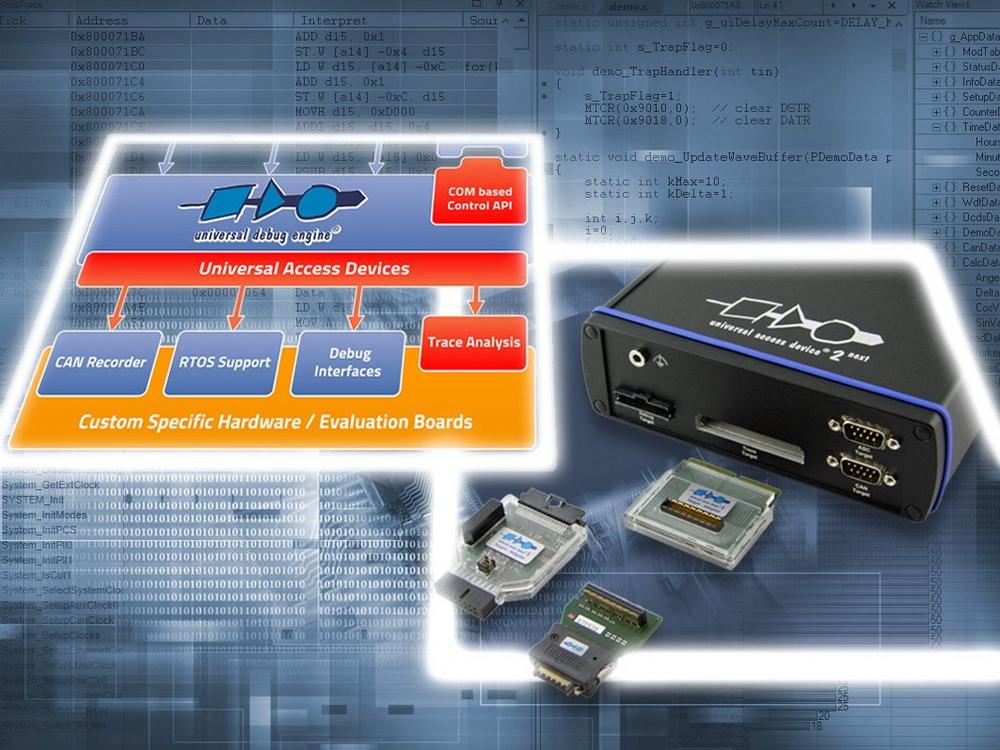Moreover, with UDE 4.10, developers will also have even more efficient graphical visualization options for analyzing the runtime behavior of applications. Based on the recorded trace data, the program sequence or the call depth can be quickly displayed over time, and that even for very large amounts of data. The visualization of the program flow makes it very easy to draw conclusions – for example, for load distribution or synchronization of software distributed on several cores – without much additional effort.
Another outstanding new feature of the UDE 4.10 is the support of ASAP2 descriptions for control unit software. ASAP2 or A2L files describe how physical values, characteristic curves and other parameters of control units are mapped and converted to program variables, internal memory structures and data types. The user can now work directly with the parameters of the electronic control unit and change them without having to worry about their actual representation in the microcontroller’s memory. Of course, user values are checked for their validity and for allowed value ranges. This makes debugging and runtime analysis of control unit software much more convenient and efficient than in the past.
The UDE 4.10 also makes work much easier for developers of complex timer algorithms for the Bosch Generic Timer Module (GTM). Where previously only assembler code was used, development and debugging in conjunction with corresponding compilers from TASKING or HighTec can now be done on the basis of C source code too.
Especially for the AURIX 2G family, the integrated FLASH programming module of the UDE 4.10 and the separately available FLASH/OTP programming tool UDE/Memtool have been extended with additional functions for smooth support of software-over-the-air. This means that it is now possible to create the prerequisites on the device for secure software updates via an existing internet connection later in the field.
In addition to UDE 4.10, PLS introduces two new trace modules for its UAD2next, the all-round access device for state-of-the-art debugging and target communication via CAN. The first module supports parallel trace and offers up to 250 MBit/s transfer speed with 12 bits and 125 MHz (DDR). The second module supports serial trace interfaces based on the AURORA protocol and transmits the trace data generated by the target via two lanes with a transfer speed of up to 1.25 GBit/s. Both modules can easily be plugged into the robust expansion slot on the front of the UAD2next.
PLS Programmierbare Logik & Systeme GmbH, based in Lauta (Germany), is a manufacturer of debuggers, emulators and trace solutions for embedded systems. Thanks to PLS’s innovative test and development tools, the company has developed into a technology leader in this area since its foundation in 1990. With its key product Universal Debug Engine® (UDE®), PLS combines powerful capabilities for debugging, testing and system-level analysis of multi-core systems and deeply embedded microcontrollers with efficiency and ease of use. The devices UAD2/UAD3+ of the Universal Access Device (UAD) product family complete UDE’s full featured debug solution with a fast, flexible and robust access to the target embedded systems.
Please visit www.pls-mc.com for further information about the company, products and services.
PLS Programmierbare Logik & Systeme GmbH
Straße der Freundschaft 92
02991 Lauta
Telefon: +49 (35722) 384-0
Telefax: +49 (35722) 384-69
http://www.pls-mc.com
3W Media & Marketing Consulting
Telefon: +49 (8761) 759203
Fax: +49 (8761) 759201
E-Mail: werner.wiesmeier@online.de
Telefon: +49 (35722) 384-0
Fax: +49 (35722) 384-69
E-Mail: jens.braunes@pls-mc.com
![]()
